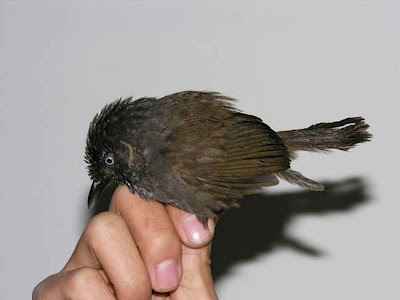 Hey... here's another amazing news that was published at ScienceDaily on Feb 8, 2009. The discovery of a new species of babbler - a rare bird has created the buzz around the Internet. Can you guess what it looks like? A bit different from the other babblers that it closely related to. Named after the reserve at which it was discovered, this new species of bird - the Nonggang Babbler has been discovered in the Guangxi province in south-west China, which is located just a few miles away from the border with Vietnam. Until 2005 there was no official news about the Nonggang Babbler. Zhou Fang and Jiang Aiwu from Guangxi University were the first couple of ornithologists, who identified this amazing babbler as an undescribed taxon in 2006. Although the Nonggang Babbler has a very close resemblance with Sooty Babbler and both these species are closely related, yet there are lots of differences in their look and behavior. Compared to Sooty Babbler, the Nonggang Babbler is a bit larger. Nonggang Babbler has white crescent patches behind the ear coverts and dark spots on the upper breast and throat.
Hey... here's another amazing news that was published at ScienceDaily on Feb 8, 2009. The discovery of a new species of babbler - a rare bird has created the buzz around the Internet. Can you guess what it looks like? A bit different from the other babblers that it closely related to. Named after the reserve at which it was discovered, this new species of bird - the Nonggang Babbler has been discovered in the Guangxi province in south-west China, which is located just a few miles away from the border with Vietnam. Until 2005 there was no official news about the Nonggang Babbler. Zhou Fang and Jiang Aiwu from Guangxi University were the first couple of ornithologists, who identified this amazing babbler as an undescribed taxon in 2006. Although the Nonggang Babbler has a very close resemblance with Sooty Babbler and both these species are closely related, yet there are lots of differences in their look and behavior. Compared to Sooty Babbler, the Nonggang Babbler is a bit larger. Nonggang Babbler has white crescent patches behind the ear coverts and dark spots on the upper breast and throat.The behavior of the Nonggang Babbler matches very much with that of a wren-babbler of genus 'Napothera'. Alike the wren babbler, Nonggang Babbler prefers motionlessness to run to fly, instead of flying off directly from motionlessness. Unlike most of the other species of babblers the Nonggang Babbler invests its time mostly on the ground, foraging for insects under the fallen leaves and gravels.
I am sure their nesting habbit might be a bit different from other birds that we commonly come across. I have been looking for it since a couple of weeks and have already consulted some informative sources. The nesting habits of this new species of babbler has not yet been discovered, as no nests have been found, although around 200 birds have been in observation in Nonggang.
"I have been studying birds in the region since the 1970s but I had never seen it before. Their habitat in the reserve is protected, but as they could also exist in the karst rainforest outside the reserve, logging and burning wood to make charcoal pose a threat to their wider habitat", said ornithologists, Zhou Fang. He also said: "The limestone area in south-western Guangxi is part of the Indo-Burma global biodiversity hotspot and the south-east Chinese Mountains Endemic Bird Area, and is one of the most typical tropical karst regions in the world. The fragility of the karst ecosystem and its destruction by people pose great threats to the bird's existence. Therefore, research and conservation of the birds in this habitat is very urgent".
"Given the bird's small number and its threatened habitat, it's important to include it in the State list of protected species," Zhou says.









No comments:
Post a Comment